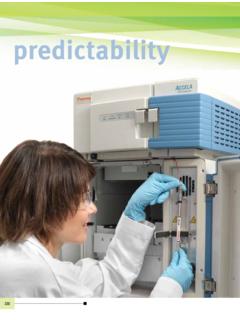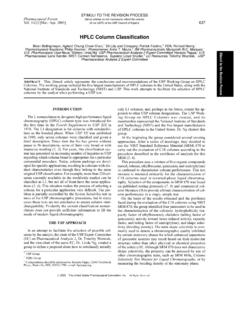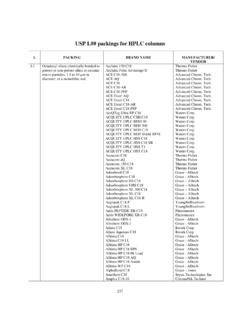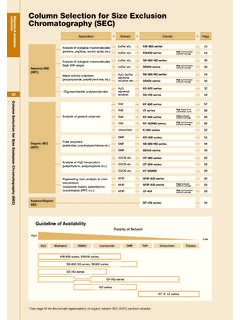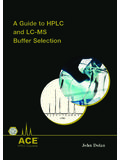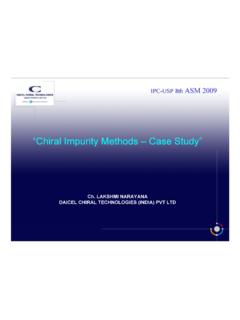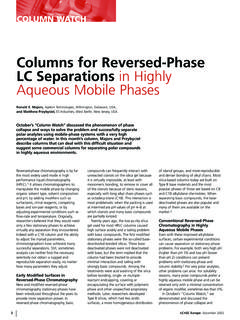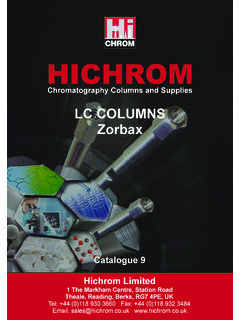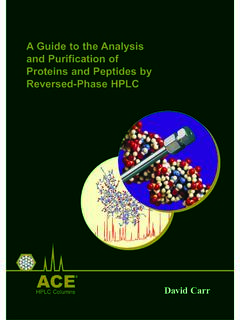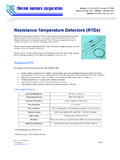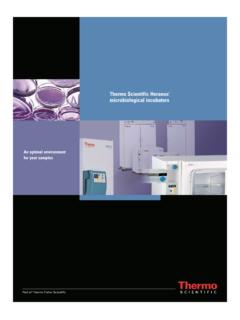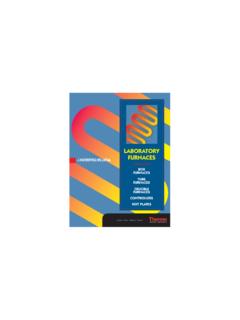Transcription of Thermo Scientific AQUASIL C18 HPLC Columns
1 Exceptional Chromatography of Polar CompoundsPart of Thermo Fisher ScientificThermo Scientific AQUASIL C18 hplc Columns Technical Guide Version 2 IntroductionThe Thermo Scientific AQUASIL C18 columnsprovide a versatile C18 phase for a widerange of a C18 phase with a hydrophilicend-capping, AQUASIL C18 Columns offer aunique material for reversed phase chroma-tography, offering alternative selectivity, upto twice the retention for polar compounds,and no phase collapse under 100% aqueousconditions. Ideal for use with LC/MS, thesecolumns maintain selectivity with reducedconcentrations of buffers and this Technical Guide, we review theAQUASIL C18 packing, designed to gobeyond the limitations of traditional C18packing materials, including.
2 Different retention and selectivity toconventional C18 Excellent peak shapes for basic,acidic and neutral compounds Polar molecule retention twice asstrong as conventional C18 Compatible with 100% aqueous mobile phase Excellent results with low buffer concentrations Stable for LC/MS applicationsChromatographic CharacterizationPackings that offer additional interactionmodes give rise to quite different retentionbehavior and selectivity. Additionally, analyteswith the greatest polar functionality willtypically show significant changes in selectivity and 1 illustrates the behavior differ-ences between the AQUASIL C18 column andthe Thermo Scientific BetaBasic 18 column(a C18 column that is highly base deactivatedand densely bonded and also has a verysimilar percent carbon value).
3 Figure 1a demonstrates that the AQUASILC18 column is slightly less retentive thanthe BetaBasic 18 column where analyteinteractions are based purely on hydrophobic(or dispersive) interactions. The AQUASIL C18packing was designed for the reversed phaseseparation of polar molecules. Despite itsrelatively high concentration of C18 groups,it also has hydrophilic sites that help to provide increased retention of highly polarwater soluble compounds (Figure 1b, 1c). Thermo Scientific AQUASIL C18 hplc Columns212neucom345 Figure 1: Chromatographic Retention Behavior AQUASIL C18 vs BetaBasic 18 Columns67812345678 BetaBasic 18 AQUASIL C18a) Less retentive for neutral compoundsb) More retentive for polar basic compounds123456123456 Sample1.
4 Uracil2. Benzene3. Ethylbenzene4. Propylbenzene5. Butylbenzene6. Pentylbenzene7. Hexylbenzene8. HeptylbenzeneColumns:5 m, 150 x mmEluent:25% H2O / 75% mL/minDetector:UV @ n-Acetylprocainamide4. Caffeine5. n-Propionylprocainamide6. PhenolColumns:5 m, 150 x mmEluent:90% 50 mM KH2PO4,pH / 10% mL/minDetector:UV@ 254 ABB-001 BetaBasic 18 AQUASIL C18c) More retentive for polar acidic compounds12341234 Sample1. Uracil2. Phloroglucinol3. Resorcinol4. PhenolColumns:5 m, 150 x mmEluent:80% FormicAcid/20% mL/minDetector:UV @ 254 polcomBetaBasic 18 AQUASIL C1802 4 6810 MinThermo Scientific AQUASIL C18 hplc ColumnsFigure 1b shows how the AQUASIL C18column offers the nearly twice the retentionof several polar, basic compounds whencompared to a BetaBasic 18 column.
5 Theretention of basic compounds and polar acidiccompounds on the AQUASIL C18 column areboth significantly increased compared to theBetaBasic 18 column. This illustrates howuseful the AQUASIL C18 column can bewhen increased retention of polar compoundsor alternative selectivity is Retention ofPolar CompoundsPolar compounds often elute near or at theunretained marker when run on typical C18 hplc Columns . AQUASIL C18 Columns provideadditional analyte-ligand interactions toreversed phase hydrophobic interactions,leading to increased retention of analytes withpolar functionality. AQUASIL C18 columnsmaintain retention of neutral compoundswhile offering increased retention for bothacidic and basic compounds.
6 Applications Highly Polar Compounds Nucleosides and Nucleotides Organic acids Vitamins Peptides CatecholaminesChromatographic InteractionsDispersive interactions are the primaryinteractions generally associated withretention using traditional alkyl C18 type packings. Secondary interactions associated withresidual silanols have been significantlyreduced by end-capping, improvements insilica quality and increased density of thederivatized ligand. Therefore, silanol inter-actions that previously gave rise to broadtailing peaks for basic analytes have beensomewhat eliminated. These secondaryinteractions are also responsible in part forthe retention of compounds with polar functionality, either by hydrogen bondinginteractions or via ion exchange progressive elimination of the secondary silanol interactions has resultedin Columns that give good peak shape forbasic compounds but reduced retention ofpolar compounds in general.
7 AQUASIL C18columns provide an excellent combinationof traditional reversed phase interactionsand polar interactions to retain morepolar SIZE PORE SIZE CARBON LOAD SILICA TYPEAQUASIL C183 and 5 m100 12%High purity, base deactivatedAQUASIL media combines C18 with hydrophilicendcapping AQUASIL Phase Specifications3 This is illustrated in Figure 2 whichdemonstrates the capability of the AQUASILC18 column s ability to separate catechol-amines without ion pair reagents in a highlyaqueous mobile phase. Highly Aqueous Mobile PhasesThe inclusion of polar functionality to thestationary phase also increases the wettingcharacteristics of the packing in highlyaqueous mobile phases.
8 The AQUASIL C18 column can be run in 100% aqueous mobile phase conditions(Figures 3 and 4) and shows no tendencytowards phase collapse. Phase collapse isoften seen with C18 packings unless a smallamount of organic solvent (1-5%) is addedto the mobile phase. As a result of phase collapse, theretention and selectivity of the phase arelost and the column must be regeneratedusing a pure organic solvent wash. TheAQUASIL C18 packing is immune to thisfolding due its unique polar 4 demonstrates that reproduciblechromatography is maintained even afterflushing with 100% aqueous mobile phasefor 113 :1. Epinephrine2. L-DOPA3. DL-Tyrosine4. Vanillylmandelic acidAQUASIL C18, 5 m, 150 x mmEluent:98% KH2PO4, pH H3PO4/ 2% mL/minDetector:UV @ 210 Figure 2: Catecholamines123402468101214 Min775-0461.
9 5'-CTP 5'-CDP 5'-CMP 5'-GDP 5'-GMP 5'-ATP 5'-ADP 5'-AMP C18, 5 m, 150 x KH2PO4, pH with mL/minDetector:UV @ 260 Figure 3: Separation of nucleotides with 100%aqueous mobile pahse12345775-008 Sample:1. Tartaric acid2. Malonic acid3. Fumaric acid4. Succinic acidAQUASIL C18, 5 m, 150 x KH2PO4+ H3PO4, pH mL/minDetector:UV @ 210 Figure 4: AQUASIL C18 compatibility with 100%aqueous mobile phase1234687432102 4 6 Min775-009 Initial RunAfter 113 Hoursof Flushing withMobile Phase4 Thermo Scientific AQUASIL C18 hplc ColumnsReduced Buffer Concentrationsand Increased MS SensitivityAt any concentration, additives such as trifluoroacetic acid can cause ion suppressionand consequently reduce sensitivity inLC/MS methods.
10 The choice of hplc columnis of key importance for LC/MS applications,since the properties of the bonded stationaryphase and underlying silica can stronglyinfluence the concentration of enhance ionization, it is good practiceto use volatile mobile phase additives inLC/MS methods. The addition of acidicmodifiers such as formic acid or TFA is commonplace when analyzing proteins andpeptides by reversed phase additive solvates the analyte, displacingwater molecules and creating a morehydrophobic analyte with stronger retentionon traditional C18 packings. The AQUASIL C18 packing can retainpeptides in their water soluble state, reducingthe need for TFA as an additive.
